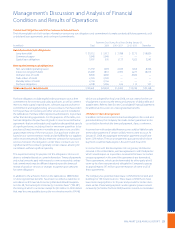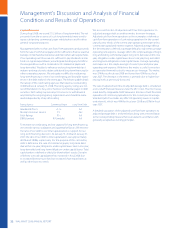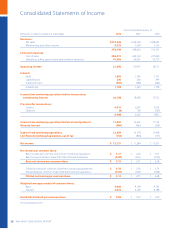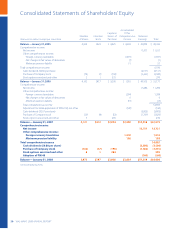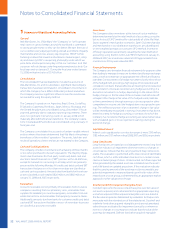Walmart 2008 Annual Report Download - page 28
Download and view the complete annual report
Please find page 28 of the 2008 Walmart annual report below. You can navigate through the pages in the report by either clicking on the pages listed below, or by using the keyword search tool below to find specific information within the annual report.
Goodwill and other indenite-lived acquired intangible assets are not
amortized, but are evaluated for impairment annually or whenever
events or changes in circumstances indicate that the value of a cer-
tain asset may be impaired. This evaluation requires management
to make judgments relating to future cash ows, growth rates, and
economic and market conditions. These evaluations are based on
determining the fair value of a reporting unit or asset using a valuation
method such as discounted cash ow or a relative, market-based
approach. Historically, the Company has generated sucient returns
to recover the cost of goodwill and other indenite-lived acquired
intangible assets. Because of the nature of the factors used in these
tests, if dierent conditions occur in future periods, future operating
results could be materially impacted.
Income Taxes
The determination of our provision for income taxes requires
signicant judgment, the use of estimates, and the interpretation and
application of complex tax laws. Signicant judgment is required in
assessing the timing and amounts of deductible and taxable items
and the probability of sustaining uncertain tax positions. The benet
of uncertain tax positions are recorded in our nancial statements
only after determining a more-likely-than-not probability that the
uncertain tax positions will withstand challenge, if any, from taxing
authorities. When facts and circumstances change, we reassess these
probabilities and record any changes in the nancial statements as
appropriate. The Financial Accounting Standards Board issued FIN 48,
which set out criteria for the use of judgment in assessing the timing
and amounts of deductible and taxable items. We adopted this inter-
pretation for scal year 2008.
Self-Insurance
We use a combination of insurance, self-insured retention and self-
insurance for a number of risks, including, without limitation, workers’
compensation, general liability, vehicle liability and the Company’s
obligation for employee-related health care benefits. Liabilities
associated with the risks that we retain are estimated by considering
historical claims experience, including frequency, severity, demo-
graphic factors and other actuarial assumptions. In calculating our
liability, we analyze our historical trends, including loss development,
and apply appropriate loss development factors to the incurred costs
associated with the claims made against our self-insured program.
The estimated accruals for these liabilities could be significantly
aected if future occurrences or loss development dier from these
assumptions. For example, for our workers’ compensation and gen-
eral liability, a 1% increase or decrease to the assumptions for claims
costs or loss development factors would increase or decrease our
self-insurance accrual by $24 million or $79 million, respectively.
During the last few years, we have enhanced how we manage our
workers’ compensation and general liability claims. As a result, our
loss experience with respect to such claims has improved and the
actuarially determined ultimate loss estimates, primarily for scal
year 2004 through 2007 claims, were reduced during the quarter
ended July 31, 2007. The reductions in ultimate loss estimates resulted
primarily from improved claims handling experience, which impacts
loss development factors and other actuarial assumptions. Due to the
benecial change in estimate of our ultimate losses, accrued liabilities
for general liability and workers’ compensation claims were reduced
by $196 million after tax, resulting in an increase in net income per
basic and diluted common share of $0.05 for the second quarter of
scal year 2008.
For a summary of our signicant accounting policies, please see
Note 1 to our Consolidated Financial Statements that appear after
this discussion.
26 WAL-MART 2008 ANNUAL REPORT
Management’s Discussion and Analysis of Financial
Condition and Results of Operations







